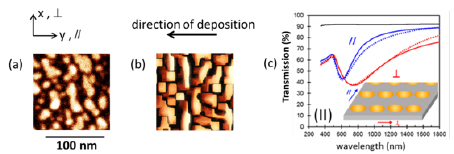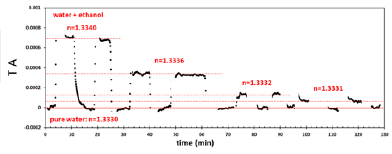Team
- Permanent members: Yves Borensztein, Sébastien Royer
The localized surface plasmon resonance (LSPR) in metallic nanoparticles (NPs) induces a strong enhancement of the electromagnetic field at the surface of the NPs. Consequently, monitoring the modification of the LSPR by molecule adsorption on the NPs surface, allows the development of plasmonic sensors. In order to achieve ultra-high sensitivity, down to a single molecule, we combine the highly sensitive technique of Reflectance Anisotropy Spectroscopy, previously developed in the group, for the study of single crystal surfaces, with anisotropic metal NP assemblies elaborated by grazing incidence evaporation on a substrate. The sensitivity achieved is hence much higher than that of conventional plasmonic sensors. Due to the “shadow” effect, the NPs films thus obtained exhibit a morphological anisotropy and, consequently, a strong dichroism (Figure 1).

Figure 1: (a) Scanning electron microscopy image of a Au sample, with a mass thickness equal to 5.0 nm, and grazing incidence for the deposit equal to 12°. (b) Monte Carlo simulation taking into account the shadowing effect. (c) Transmission spectra for polarization of light, parallel (blue) and perpendicular (red), to the direction of deposition. Dotted lines: experimental data; continuous lines: calculation based on the model schematized in the inset. The black curve is the transmittance of the bare glass slide.
Using such films formed by flat elongated metal NPs, we investigated the reaction of hydrogen with gold NPs [1], we developed a prototype hydrogen sensor, based on Pd NPs [2]. More recently, high bulk sensitivity to refractive index changes has been demonstrated, as change of 10-4 of the index of refraction of the ambient medium could be achieved [3]. This is illustrated in Figure 2. In addition, we have theoretically shown that such a sensitivity, in the case of adsorption of biomolecules, should make it possible to achieve ultra-high sensitivity down to a single biomolecule, of size equivalent to that of avidin.

Figure 2: Monitoring of the Transmission Anisotropy signal, , at a fixed wavelength, during successive changes in the refractive index of water/ethanol solutions, as a function of time. The sensitivity reached in variation of the refractive index is δn=10-4.
In the future, several directions will be followed. First, we will develop efforts to improve the elaboration of the samples, in order to increase the sensitivity capacity of the sensors. In particular, we will elaborate “sandwich” samples, composed of gold NPs in interaction with a metallic surface at a given distance. Such a system can induce so-called Fano resonances, with a higher figure of merit. Secondly, we will use this method to investigate the presence of bio-molecules in liquid media (avidine / biotin couple; detection of pathogenic entities, etc.), by focusing on several aspects: sensitivity, selectivity, repeatability, response time, etc.
Transversal topic
Nano Photo-phononique
Publications
- William Watkins, Yves Borensztein. Mechanism of hydrogen adsorption on gold nanoparticles and charge transfer probed by anisotropic surface plasmon resonance. Physical Chemistry Chemical Physics, Royal Society of Chemistry, 2017, 19 (40), pp.27397 – 27405. ⟨10.1039/C7CP04843B⟩. ⟨hal-01627748⟩
- William Watkins, Yves Borensztein. Ultrasensitive and fast single wavelength plasmonic hydrogen sensing with anisotropic nanostructured Pd films. Sensors and Actuators B: Chemical, Elsevier, 2018, 273, pp.527 – 535. ⟨10.1016/j.snb.2018.06.013⟩. ⟨hal-01897321⟩
- William Watkins, Antonio Assaf, Geoffroy Prévot, Yves Borensztein. Dichroic Plasmonic Films Based on Anisotropic Au Nanoparticles for Enhanced Sensitivity and Figure of Merit Sensing. Journal of Physical Chemistry C, American Chemical Society, In press, 125, pp.11799 – 11812. ⟨10.1021/acs.jpcc.1c03841⟩. ⟨hal-03235148⟩

